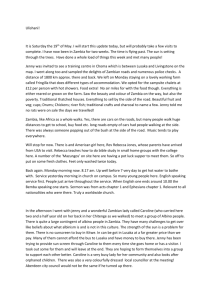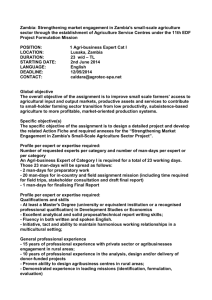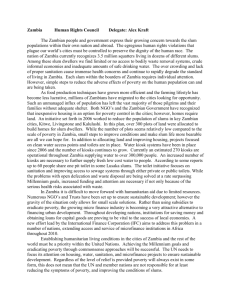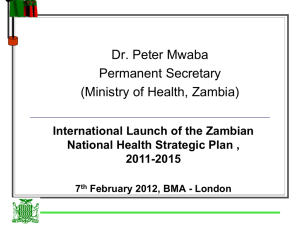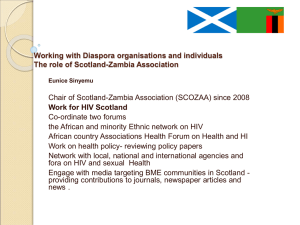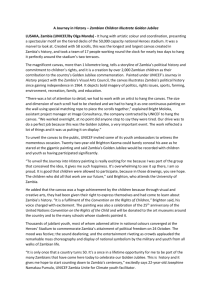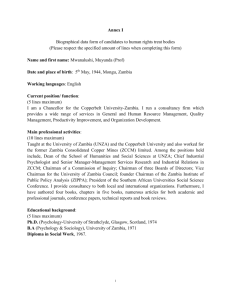Zambia - The Society for Historians of American Foreign Relations
advertisement
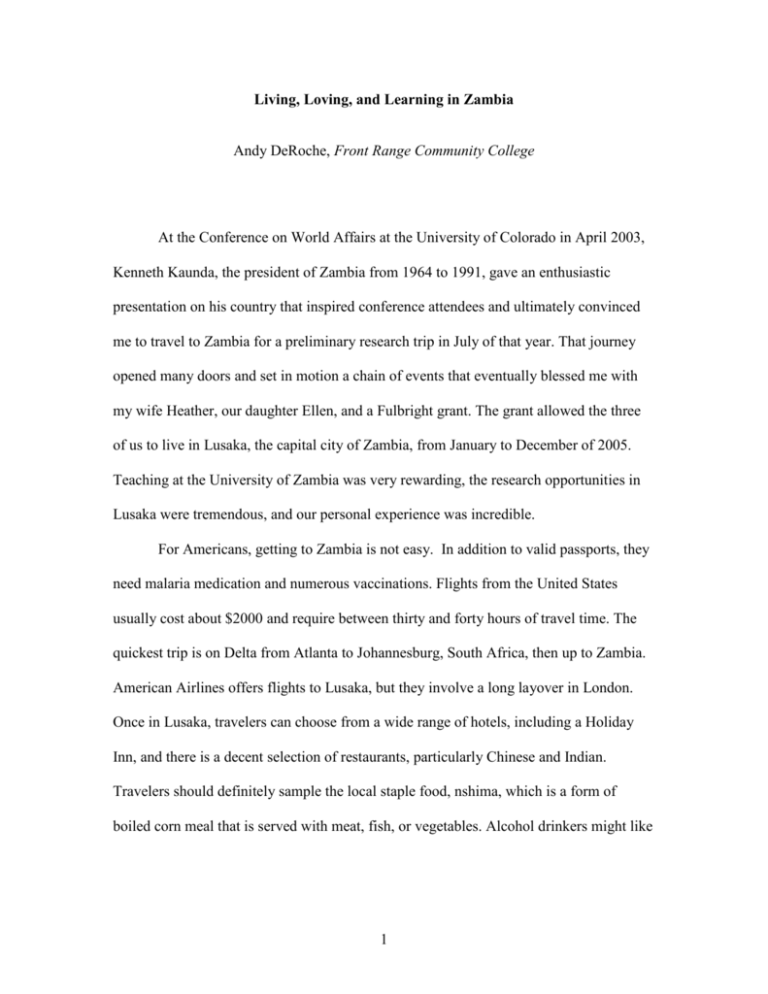
Living, Loving, and Learning in Zambia Andy DeRoche, Front Range Community College At the Conference on World Affairs at the University of Colorado in April 2003, Kenneth Kaunda, the president of Zambia from 1964 to 1991, gave an enthusiastic presentation on his country that inspired conference attendees and ultimately convinced me to travel to Zambia for a preliminary research trip in July of that year. That journey opened many doors and set in motion a chain of events that eventually blessed me with my wife Heather, our daughter Ellen, and a Fulbright grant. The grant allowed the three of us to live in Lusaka, the capital city of Zambia, from January to December of 2005. Teaching at the University of Zambia was very rewarding, the research opportunities in Lusaka were tremendous, and our personal experience was incredible. For Americans, getting to Zambia is not easy. In addition to valid passports, they need malaria medication and numerous vaccinations. Flights from the United States usually cost about $2000 and require between thirty and forty hours of travel time. The quickest trip is on Delta from Atlanta to Johannesburg, South Africa, then up to Zambia. American Airlines offers flights to Lusaka, but they involve a long layover in London. Once in Lusaka, travelers can choose from a wide range of hotels, including a Holiday Inn, and there is a decent selection of restaurants, particularly Chinese and Indian. Travelers should definitely sample the local staple food, nshima, which is a form of boiled corn meal that is served with meat, fish, or vegetables. Alcohol drinkers might like 1 Zambian brews such as Mosi or Rhino, which are quite good. Soft drinks and bottled water are also widely available. My initial four-day visit to Lusaka in 2003 was somewhat disappointing in terms of research. The Zambian National Archive was closed the first two days for national holidays, and the two remaining days allowed me only enough time to gain entrance and look at newspapers from the 1970s. In personal matters, my luck was much better. Gabriel Banda, special assistant to Kenneth Kaunda, found me walking near my hotel, and we had dinner. He accompanied me to the airport the next morning, which proved fortunate for me when the airlines informed us that the flight to Livingstone (in southern Zambia near Victoria Falls) had been changed and was long gone. Gabriel calmly told me that a bus would get me there just fine, and he facilitated the extremely challenging maneuvers required to reach the bus station and acquire a ticket. It turned out that there was one seat open on the bus, and it was next to a Zambian journalist named Heather Choonya. She had come to Lusaka for a conference that had unexpectedly been cancelled, so she was returning to Livingstone early. The bus ride normally takes about seven hours, but because the bus ran out of fuel, this one lasted closer to ten hours. Heather quickly befriended her strange American traveling companion. She even bought me chicken and chips for lunch at the rest stop, since my Zambian currency was all gone. When we finally reached Livingstone the friend who had agreed to meet me was nowhere to be found, so Heather helped me check into a hotel. She came back the next morning to guide me across the border into Zimbabwe. Heather’s kindness motivated me to apply for a Fulbright grant in August after I returned to Colorado. The committee approved my application in April, but the best was 2 yet to come. In June 2004 Heather and I got married on the Zambezi River just above Victoria Falls, and our daughter Ellen was born in Boulder at the end of the year. In January 2005 the three of us flew to Zambia for an unforgettable adventure. Our daily lives in Lusaka, where Heather grew up, were challenging and rewarding. We had the wonderful opportunity to spend lots of time with her family, and we participated in many powerful events, including the wedding of Heather’s sister and the funeral of her grandfather. Heather’s family was kind and giving to all of us, but understandably they were most excited about playing with Ellen, who is infinitely more adorable than her dad. My grant included a teaching component, and my academic affiliation was with the University of Zambia (UNZA). The chair of the history department, Dr. Webby Kalikiti, was a gracious host. During the first term we team-taught one section of the U. S. history survey, and then I taught one section on my own during the second term. Covering all of American history in a semester was a new experience for me, but useful in that it forced me to rethink what material is most critical. Classes met at a different time and in a different room each day, which made me pay attention to when and where I was going! The courses consisted of three one-hour lectures per week and one tutorial session for discussion. The students were all seniors in the School of Education preparing for careers as teachers, and working with them was a real joy. In the 1970s and 1980s, UNZA was a top-notch facility with state-of-the-art equipment. That is no longer the case. Classrooms have fallen into disrepair, and the library has not purchased new books for about ten years. In spite of the difficult conditions, the students’ work was truly excellent. Their papers were hand-written, but nonetheless as good as the work at the University of 3 Colorado or Denver University, where all the students have their own computers. The Zambian students’ strong skills and positive attitudes compensated for their lack of resources, and their background knowledge made for a pleasant change. It was quite a treat to be able to discuss American policies toward nations like Angola or the Congo without needing to point out their locations on the map or review their colonial histories. The relatively light workload at UNZA allowed me plenty of time for research, but it was not clear at first if there was enough material to keep me busy. I knew there were useful newspapers, and I hoped to arrange some interviews with former politicians and diplomats, but I did not expect to find much in the way of archival material. I was wrong! A chance conversation connected me with Dr. Marja Hinfelaar, a scholar of religious history overseeing the digitizing of materials at the Zambian National Archives. Marja is an extremely helpful contact for anyone considering a research trip to Lusaka, as she is very knowledgeable about all of the archival holdings there. She suggested that the place for me to start was the just-opened Political Archives of the United National Independence Party (UNIP). She and her colleague, Dr. Giacomo Macola, had recently completed the Herculean task of organizing the UNIP holdings. She told me that this collection would be a gold mine for me, and she was right! Marja escorted me to the UNIP party headquarters for my first visit in mid-March and introduced me to the officials responsible for overseeing the archives. Andrew Nyambe, who was at that time completing a course in library studies at Evelyn Hone College in Lusaka, is the key contact for researchers wanting to gain admittance. After introductions and the payment of a membership fee (approximately $150), we walked to the archives, which are housed in a modest one-room structure in an enclosed courtyard. 4 There are a few tables and chairs for researchers, but most of the room is taken up by metal shelves lined with cardboard boxes. These boxes contain the official records of the UNIP, the party of Kenneth Kaunda, which ruled Zambia from 1964 to 1991. These records are all the more important because from 1973 on, Zambia was officially a oneparty state. From March until September, most of my research time was spent at the UNIP archives. I visited once or twice per week, and ninety percent of the time I was working alone. Not only were there not any other researchers in the library, there were rarely any staffers present. Having done much of my previous research in the closely supervised environments of the National Archives and the Lyndon Johnson Library, I found it an incredible experience to wander around alone and retrieve boxes myself. If researchers plan to spend full days at the UNIP archive they should pack a lunch, although it is never difficult to find someone to buy a Coke from, like Petwell Munshya. The only downsides to working at the UNIP were the absence of a photocopier and the presence of rat droppings (and on one occasion the rat himself). Fortunately the rat did not seem interested in the Foreign Affairs file, which contained twenty-five boxes of very interesting materials from the late 1960s to the mid1980s. The reports from Zambian embassies in the United States, the United Kingdom, the Soviet Union, and the People’s Republic of China were extremely useful. Those from Zambian embassies in other nations such as Mozambique, Canada, and Portugal were often helpful as well. Several other files contained relevant documents. The records from the Office of the President, for example, featured a fascinating letter from Kenneth Kaunda to Jimmy Carter in 1980 in which Kaunda defended his decision to purchase 5 Soviet MIGs. In addition to the documents, the library holds a wide range of published works (mostly by Kaunda) and hundreds of photographs. Having worked my way through the relevant boxes at the UNIP archives by September, I then shifted my research to the Zambian National Archives (ZNA). The ZNA is much larger and busier than the UNIP archives, since the library is a popular resource for local students. The reading room is comfortable and has a large table reserved for members. (It cost me about $50 to join for three months.) There is a photocopier, but it breaks down often; when it does, a worker can make copies next door. In general the staff is helpful, although occasionally some lack energy or enthusiasm. Do not be surprised if one of them asks for a few dollars and says that he has not eaten all day. (Sadly, many Zambians still go hungry.) Researchers who need a meal will find a very good cafeteria across the street, and many more options, including Subway, are a short taxi ride away. Since I had only limited success during my visit in 2003 my hopes were not high, but fortunately I was once again wrong. The ZNA actually has a very significant amount of relevant material for scholars of foreign relations. The official records of the Ministry of Foreign Affairs from 1964 into the early 1970s are open and listed clearly in a finding aid. Many of the most useful documents are reports from Zambian embassies in the United States, the USSR, the United Kingdom, and the People’s Republic of China. Of particular interest to me were the reports and letters that dealt with nuclear weapons. The archives also contain the personal papers of numerous former government officials such as Andrew Sardanis, one of Kaunda’s key economic advisors in the 1960s. The collection of Zambian newspapers is quite valuable, but it is challenging to use because there is no 6 index and the large boxes of original (not microfilmed) papers are difficult to manipulate. Another important written source, available both at the ZNA and at the University of Zambia library, is the record of the National Assembly debates from 1965 through the 1980s. The final piece of my research puzzle involved interviewing former Zambian government officials. Arranging the meetings required persistence and patience, and without support from Zambian friends and American colleagues most of the interviews would not have taken place. Gabriel Banda arranged my second interview with Kaunda (the first had been in Boulder in 2003). Gabriel also facilitated two sessions with Elijah Mudenda, who served as foreign minister in the early 1970s and then became prime minister. After our second interview the former prime minister and his wife invited my family for a wonderful lunch, which was one of the most memorable experiences of our year in Zambia. Lining up an interview with Vernon Mwaanga became something of an obsession for me. Mwaanga joined Zambia’s Ministry of Foreign Affairs literally on day one, and was named ambassador to the Soviet Union in 1965 at the ripe old age of twenty-one. He was foreign minister in the mid-1970s, then again in the 1990s. In 2005 he was back in government as the minister of information. My first visit to his office in hopes of scheduling an interview was in August, and only after I had returned seven more times did our discussion finally take place in December. Mwaanga talked enthusiastically for nearly two hours, so it was worth the wait. Perhaps the most valuable interview of all, however, was my last one. On 24 December, our final Saturday in Zambia, Mark Chona graciously invited me to his home, and we had a ninety-minute conversation. Chona was 7 Kaunda’s most trusted advisor and key emissary from 1966 to 1980. He answered all of my questions frankly and insightfully, but to find out what he told me you will have to buy my next book! Joking aside, the material gathered during our year in Zambia should keep me busy for the rest of my career. If anyone is interested in a research trip to Lusaka, feel free to contact me with any questions. The rat at the UNIP archives is probably getting lonely. 8
